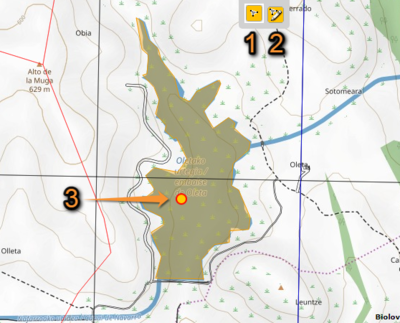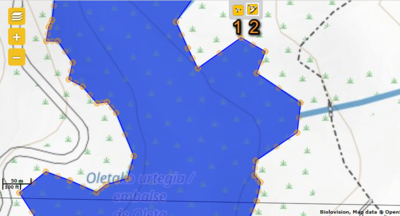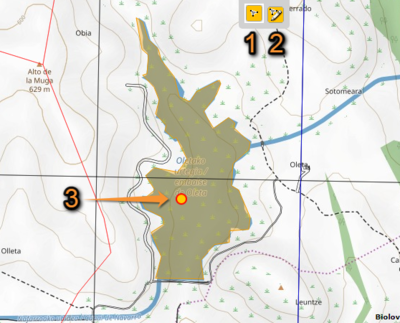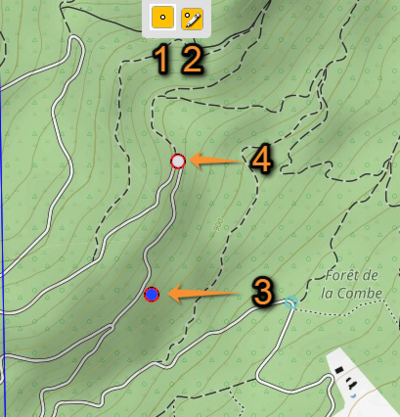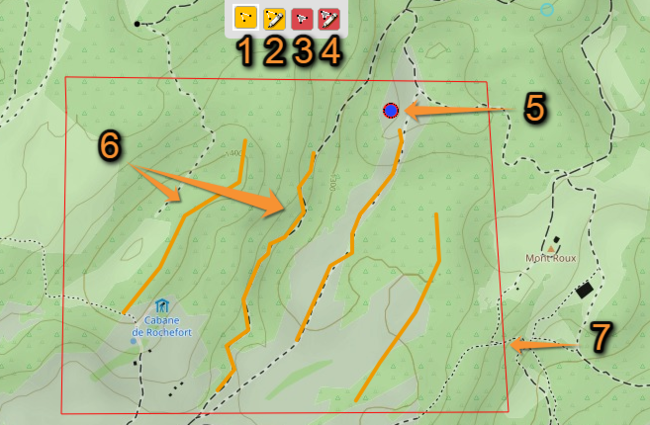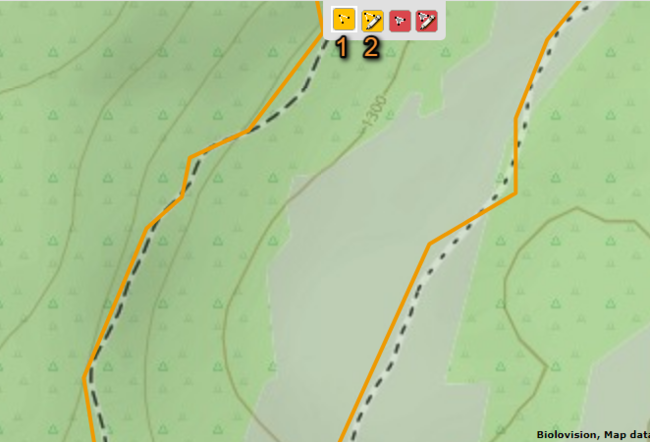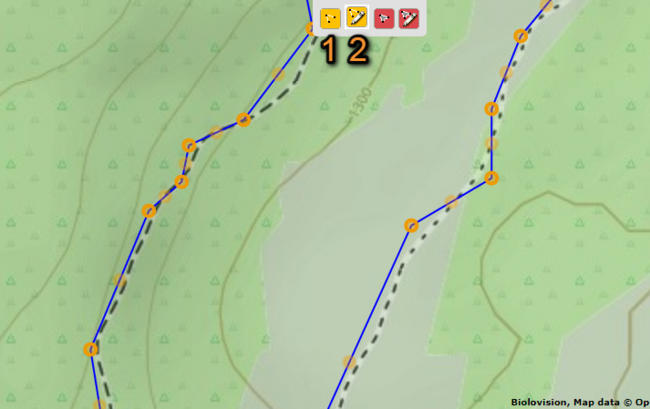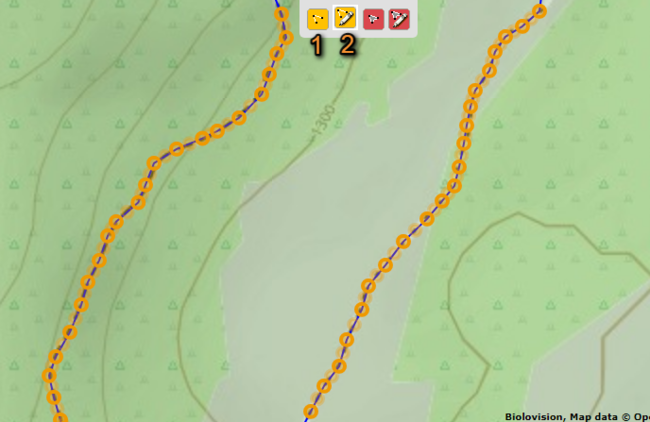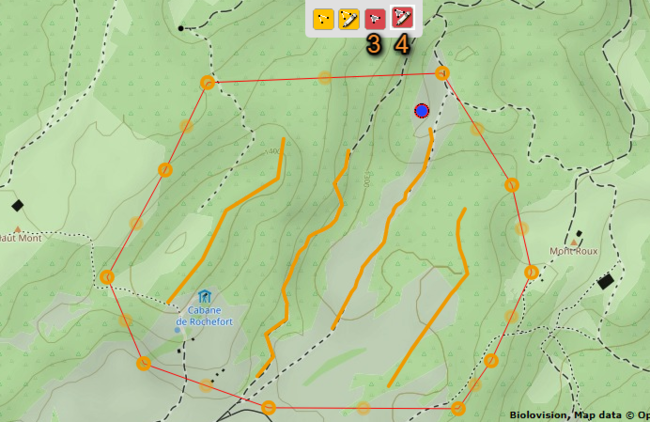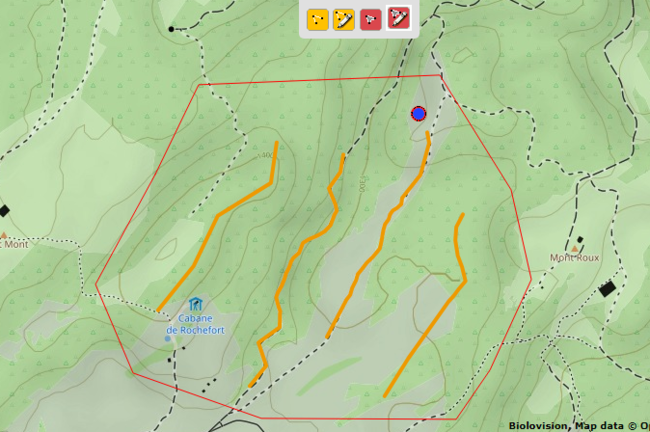Geometry editor
Some studies require defining a study area, be it a polygon, a transect or a point (for example, in projects and protocols). Only observations within a polygon, or from a transect or point will be considered for data analysis. All other observations that occur during the same session but outside our study area, will be considered outside the study.
Whenever a screen like the one in the picture below appears, a user or administrator can draw or edit the study area.
Drawing a polygon
Only administrators can draw polygons to create new study sites.
-
TO DRAW
1. Display area to draw at on the map area
2. Select drawing icon
3. Left click to start drawing
4. Click to follow the perimeter
5. Double click to close polygon
To draw a polygon:
1. Display the whole area to include in the polygon within the map area. To know how to navigate the map area, visit wiki section Web interface > Navigating the map.
2. Select the drawing icon by clicking on the left icon at the top of the map area (see number 1 in image Geometry editor tool above). A hollow light blue dot will appear at your pointer.
3. Use the left button on your mouse to click on any point of the perimeter to start drawing the polygon. Although you can click anywhere, it is easier to do so on a corner. Try to be as precise as possible, it will save you time later. However, there is no need to be exact as the polygon can be edited later.
4. Continue clicking on different points of the polygon perimeter to slowly delimit the area. Note the light blue colour indicating the area that is currently considered for the study (see image Drawing polygon). It is easier if you click the angles of the polygon to draw. Try to be as precise as possible, but the polygon can be modified later for precision.
5. When the whole perimeter is drawn, double click with the left button to close the polygon and end drawing. It can be done from any point but it is recomended to do so from the last corner before the one you started from. The finished polygon becomes orange.
Editing a polygon
Editing a polygon that has just been created allows to follow the perimeter of the study area with more precision. Administrators may want to edit polygons as part of the creation of new study sites.
Both users and administrators can edit already existig polygons.
To edit a polygon:
1. Zoom in to see the limits of the study site even if the whole polygon does not fit within the map area.
2. Click on the Edit icon at the top of the map area (number 2 in image Edit polygon above).
3. Click on the polygon area. It becomes dark blue, indicating it is possible to edit it. Corners are highlighted in darker orange and intermediate points are lighter orange.
4. Left click on any orange dot you would like to modify. Hold and drag the dot to its new position. Note when moving dots new ones will appear allowing you be as precise as necessary. Move the map to access a different part of the polygon, until the whole polygon is edited. To know how to move the map visit wiki section Web interface > Navigating the map.
5. When the polygon follows exactly the limits you are interested at, click anywhere outside the polygon area. The finished polygon becomes orange.
Drawing a point
Only administrators can draw points to create new study sites.
-
TO DRAW
1. Display area to draw at on the map area
2. Select drawing icon
3. Right click to place the point
4. Repeat at new location if more than one point is needed
To draw a point:
1. Display the area of the study site within the map area. To know how to navigate the map area, visit wiki section Web interface > Navigating the map.
2. Select the drawing icon by clicking on the left icon at the top of the map area (see number 1 in image Geometry editor. Points. below).
3. Use the right button on your mouse to place the point at the study area. A red-edged grey dot will indicate the position (see number 4 in image Geometry editor. Points. below). The point is immediately saved.
4. Repeat the process to place as many points as needed. If the maximum number of points is already reached for the selected project or protocol, a warning sign will appear.
Editing a point
Edit a point to change its position. Both users and administrators can edit already existing points.
To edit a point
1. Click on the Edit icon at the top of the map area (number 2 in image Geometry editor. Points. above).
2. Click and drag the point to be edited. Release the mouse button to leave the point at a certain placement.
3. Click on any point of the map to stop editing.
Drawing a transect
Only administrators can draw transects to create new study sites.
-
TO DRAW
1. Display area to draw at on the map area
2. Select drawing transects icon (in yellow)
3. Left click to start drawing
4. Click along the route to draw transect
5. Double click to end transect
6. Repeat the process for as many transects as needed
7. Enclose all transects repeating the process with study area icons (in red)
To draw a transect:
1. Display the whole area to include in the study within the map area. To know how to navigate the map area, visit wiki section Web interface > Navigating the map.
2. Select the drawing icon by clicking on the left icon at the top of the map area (see number 1 in image Drawing transects, in yellow). A hollow light blue dot will appear at your pointer.
3. Use the left button on your mouse to click on any point of the transect to start drawing the route. Although you can click anywhere, it is easier to do so on corners. Try to be as precise as possible, it will save you time later. However, there is no need to be exact as the transect can be edited later.
4. Continue clicking on different points of the intended route to draw the transect. Note the light blue colour indicating the route (see image as an example). Try to be as precise as possible, although it can be modified later.
5. When the route is fully designed, double click with the left button to end drawing. The finished transect becomes orange (number 6 in image Drawing transects below).
6. Repeat the process for as many transect as needed at the study site.
7. Optionally, repeat the same process with red icons to enclose all transects belonging to the same study site (see image below).
Editing a transect
Editing a transect that has just been created allows to follow the route with more precision. Administrators may want to edit transects as part of the creation of new study sites.
Both users and administrators can edit already existing transects.
To edit a transect:
1. Zoom in to see transect details even if the whole study area does not fit within the map area.
2. Click on the Edit icon at the top of the map area (number 2 in image Edit polygon above).
3. Click on any transect within the study area. All transects will become dark blue, indicating it is possible to edit them. Corners are highlighted in darker orange and intermediate points are lighter orange.
4. Left click on any orange dot you would like to modify. Hold and drag the dot to its new position. Note when moving dots new ones will appear allowing you to be as precise as necessary. Move the map to access different parts of the study area, until all transects are edited. To know how to move the map visit wiki section Web interface > Navigating the map.
5. Adjust the limits of the study area if necessary. Click on Edit the study area icon (see image below) and repeat the process.
5. When satisfied with the result, click anywhere outside the study area to finish editing.

